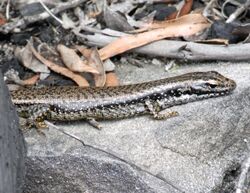Biology:Eulamprus
| Eulamprus | |
|---|---|

| |
| Eulamprus quoyii (golden water skink) | |
| Scientific classification Error creating thumbnail: Unable to save thumbnail to destination
| |
| Domain: | Eukaryota |
| Kingdom: | Animalia |
| Phylum: | Chordata |
| Class: | Reptilia |
| Order: | Squamata |
| Family: | Scincidae |
| Subfamily: | Sphenomorphinae |
| Genus: | Eulamprus Fitzinger, 1843 |
| Species | |
|
Five, see text. | |
Eulamprus is a genus of lizards, commonly known as water skinks, in the subfamily Sphenomorphinae of the family Scincidae. The genus is native to Australia .
Taxonomy
The genus Eulamprus belongs to a clade in the Sphenomorphus group that contains other genera such as Ctenotus and Anomalopus. The molecular phylogenetic studies of O'Connor and Moritz (2003) and Skinner et al. (2013) found that species assigned to Eulamprus comprised four independent lineages within the Australian Sphenomorphus group and did not form a clade. The genus Eulamprus was restricted to the water skinks, with other species assigned to Concinnia (including species formerly in the monotypic genera Gnypetoscincus and Nangura), Silvascincus and Tumbunascincus.[1][2]
Species
The following five species are recognized as being valid.[3]
- Eulamprus heatwolei Wells & Wellington, 1983 – warm-temperate water-skink, Heatwole's water skink
- Eulamprus kosciuskoi Kinghorn, 1932 – alpine meadow-skink, alpine water skink
- Eulamprus leuraensis Wells & Wellington, 1983 – Blue Mountains water skink, Blue Mountain swamp-skink
- Eulamprus quoyii Quoy & Gaimard, 1824 – golden water skink, eastern water-skink, eastern water skink
- Eulamprus tympanum (Lönnberg & Andersson, 1915) – southern water skink, cool-temperate water-skink, highland water skink, Dreeite water skink
Species formerly placed in Eulamprus
- Concinnia ampla (Covacevich & McDonald, 1980) – lemon-barred forest-skink
- Concinnia brachyosoma (Lönnberg & Andersson, 1915) – northern barsided skink
- Concinnia frerei (Greer, 1992) – stout barsided skink
- Concinnia martini Wells & Wellington, 1983 – dark barsided skink
- Concinnia sokosoma (Greer, 1992) – stout barsided skink
- Concinnia tenuis (Gray, 1831) bar-sided forest-skink, barred-sided skink
- Concinnia tigrina (De Vis, 1888) – yellow-blotched forest-skink, rainforest water-skink
- Silvascincus murrayi (Boulenger, 1887) – blue-speckled forest-skink
- Silvascincus tryoni (Longman, 1918) – Border Ranges blue-spectacled skink, forest skink, Tryon's skink
- Tumbunascincus luteilateralis (Covacevich & McDonald, 1980) – orange-speckled forest-skink
References
- ↑ O'Connor, David; Moritz, Craig (2003). "A molecular phylogeny of the Australian skink genera Eulamprus, Gnypetoscincus and Nangura". Australian Journal of Zoology 51 (4): 317–330. doi:10.1071/ZO02050.
- ↑ Skinner, Adam; Hutchinson, Mark N.; Lee, Michael S.Y. (Dec 2013). "Phylogeny and divergence times of Australian Sphenomorphus group skinks (Scincidae, Squamata)". Molecular Phylogenetics and Evolution 69 (3): 906–918. doi:10.1016/j.ympev.2013.06.014. PMID 23810993.
- ↑ Eulamprus. The Reptile Database. www.reptile-database.org.
Further reading
- Austin, J.J., & Arnold, E.N. (2006). Using ancient and recent DNA to explore relationships of extinct and endangered Leiolopisma skinks (Reptilia: Scincidae) in the Mascarene islands. Molecular Phylogenetics and Evolution 39 (2): 503–511. doi:10.1016/j.ympev.2005.12.011 (HTML abstract).
- Fitzinger, L. (1843). Systema Reptilium, Fasciculus Primus, Amblyglossae. Vienna: Braumüller & Seidel. 106 pp. + indices. (Eulamprus, new genus, p. 22). (in Latin).
- Shea, G.M., & Michels, J.P. (2008). A replacement name for Sphenomorphus keiensis (Kopstein, 1926) from the southeastern Moluccas, Indonesia (Reptilia: Squamata: Scincidae) with a redescription of the species. Zoologische Mededelingen Leiden 82 (52): 737–747. PDF.
Wikidata ☰ Q751866 entry
 |

